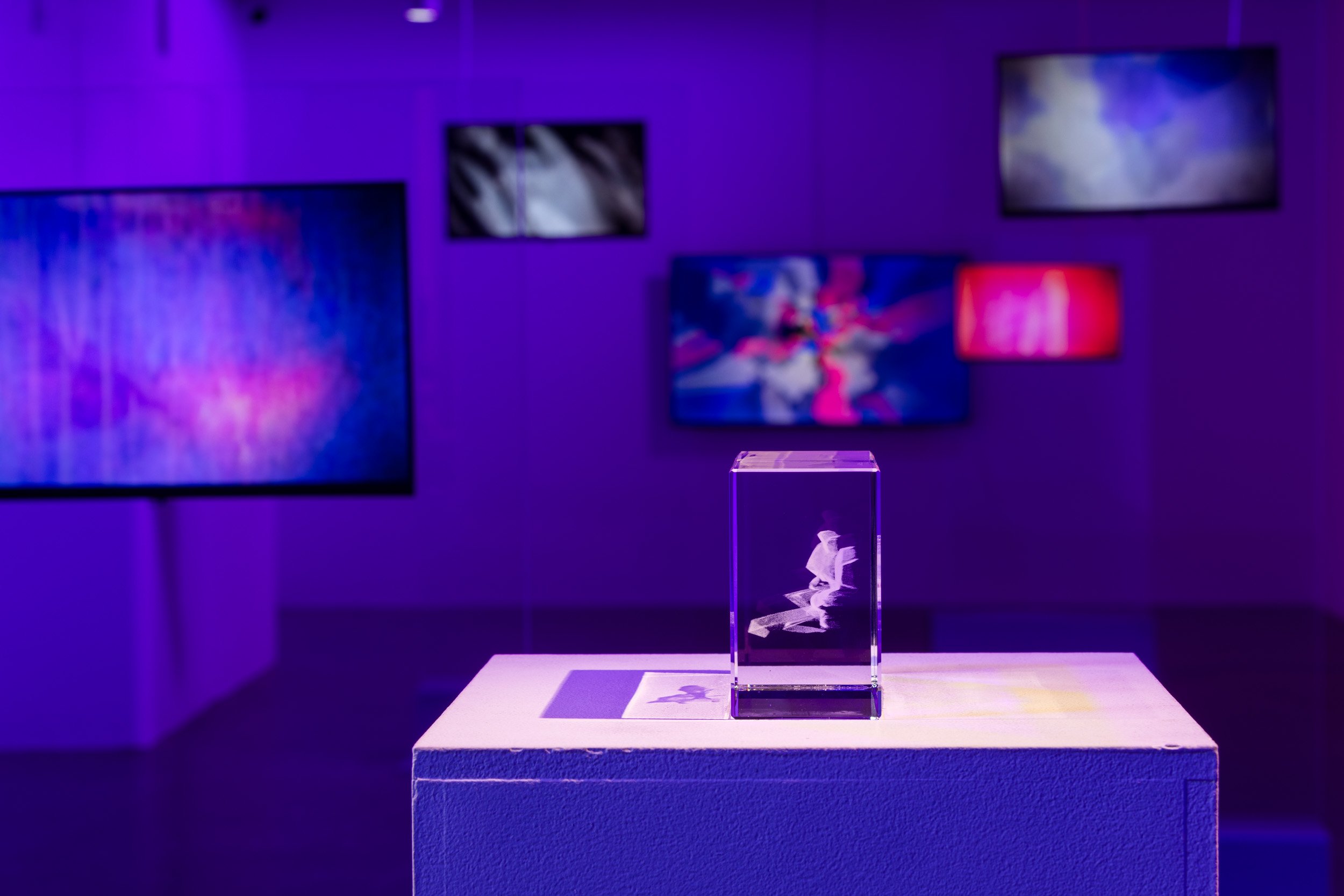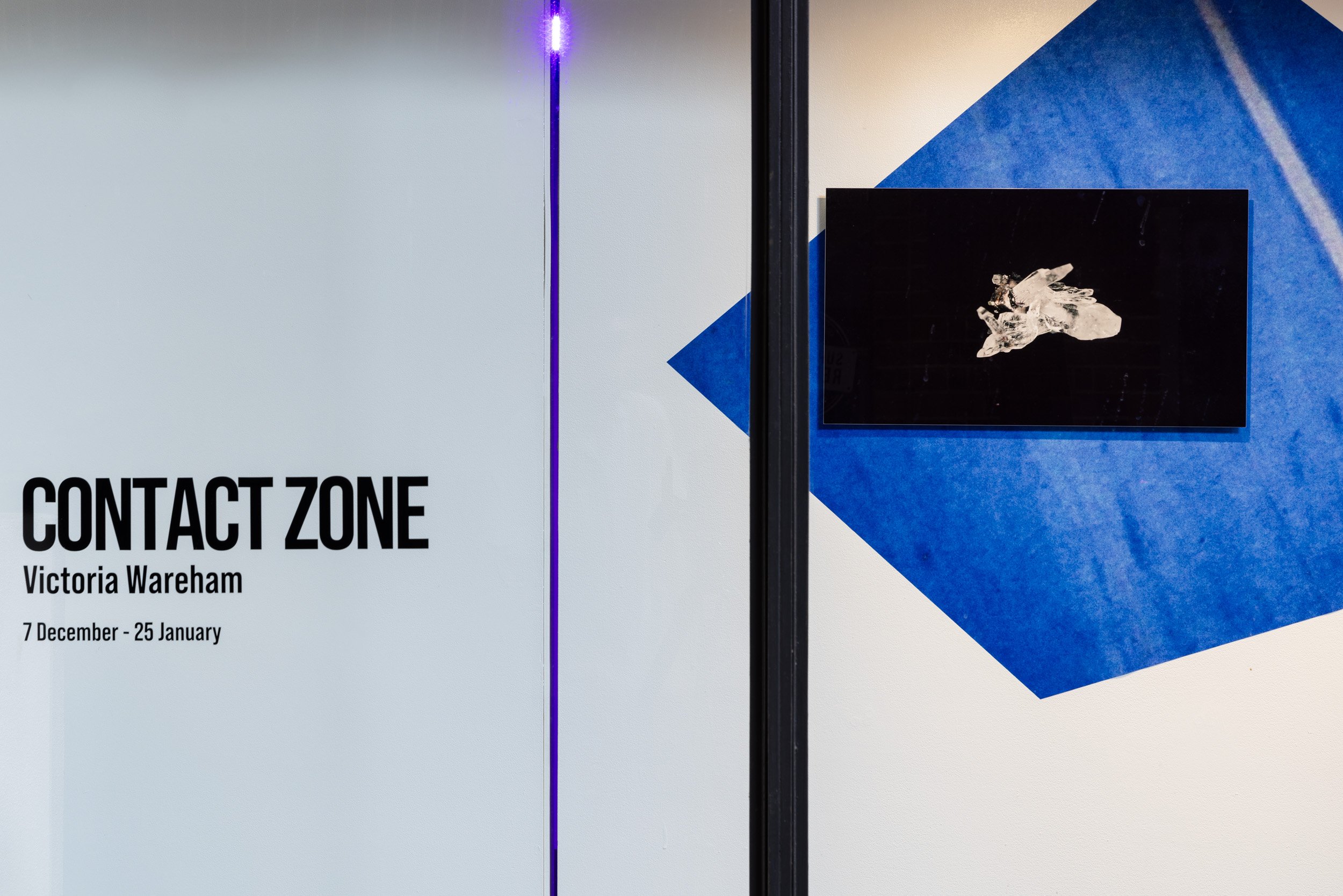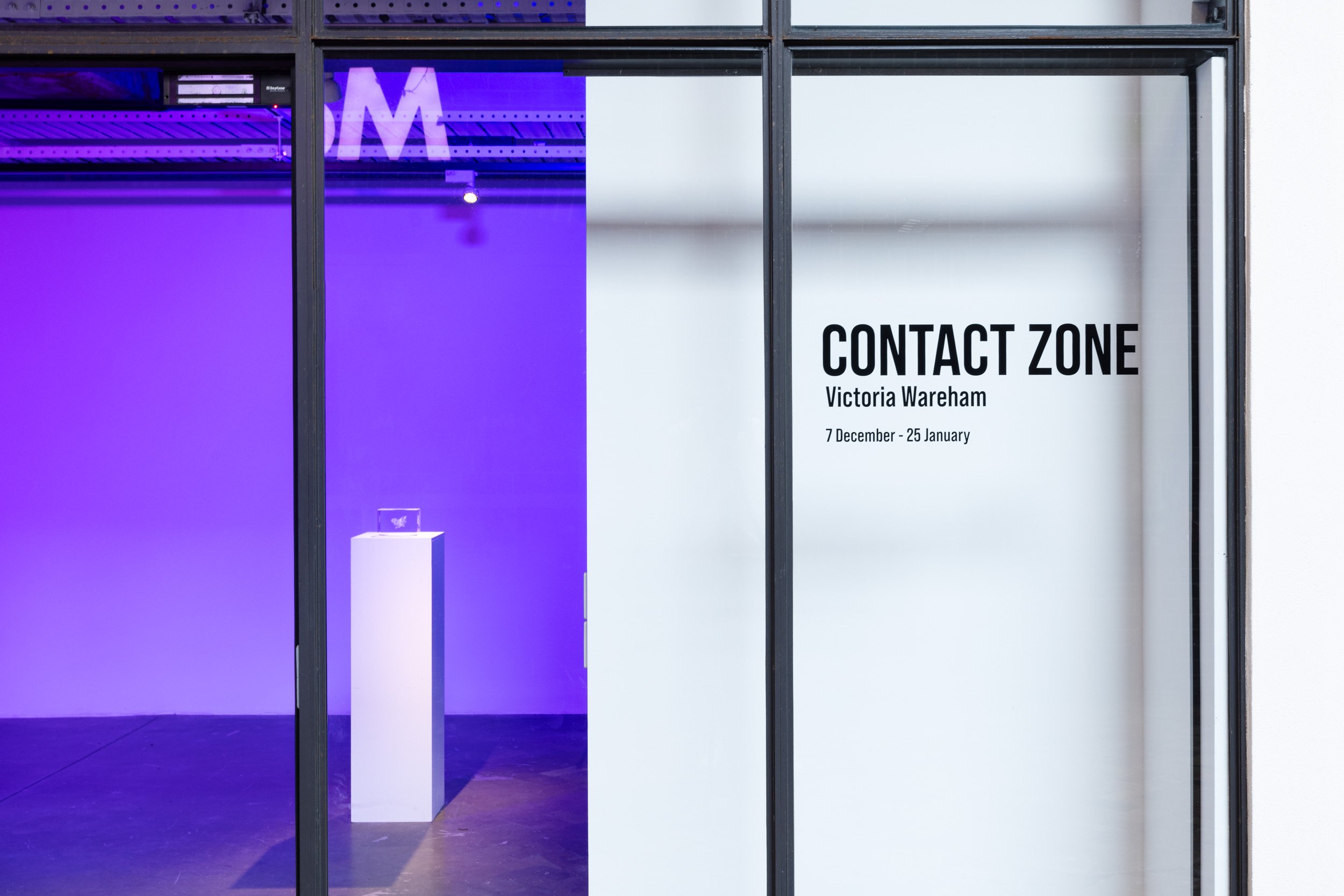
Contact Zone
2024–25
Metro Arts | Brisbane | 7 December 2024 – 25 January 2025
Exhibition text by Tara Heffernan, photography by Joe Ruckli
Everything is becoming science fiction.
—J.G. Ballard, 1971.
Obsolescence never meant the end of anything, it’s just the beginning.
—Marshal McLuhan, 1967.
Italian director Michelangelo Antonioni’s first full English-language film Blow-Up (1966) interrogates the relationship between the image and reality. It follows a day in the life of a fashion photographer who becomes obsessed with the grainy fragment of a larger image. Blown-up, this fragment appears to provide evidence of a crime he unwittingly witnessed. While much has been said about the film’s commentary on the status of the photograph, a scene often neglected by film scholars features an abstract painting. In the film, the artist describes his painting as mysterious: ‘they don’t mean anything when I do them,’ he explains ‘They are just a mess’.[1] The film was produced in an era when photography was, thanks to its new accessibility and higher image quality, increasingly employed as a probing technology of surveillance and a source of titillation. Like the abstract canvas, the blown-up image is a mystery. Its blotchy composition recalls the all-over quality of modern painting, and—crucially—it draws attention to its materiality.
Echoing this material emphasis, installation OLED For Real (2023-2024) features a super-8 animation created from stills that have been drawn on by hand. The result is a flickering, abstract collage of images and textures that appear spectral or spore-like, resembling microscopic images of a virus. This video, like much of Victoria Wareham’s practice, can be productively read in conversation with avant-garde filmmaking techniques (particularly those of structural filmmakers like Stan Brakhage and Hollis Frampton), science fiction and mysticism. For her part, Wareham describes the emphasis on the materiality of the physical film as representing “the imagined ‘thoughts’ of the screen.” Contact Zone is a testament to this desire to channel the screen, and its zones, beyond conventional engagements with screen culture. Rather than simply a medium, Wareham posits screen space as an alternate realm or dimension in its own right.
The expanded notion of the screen includes crystals, which feature too in the aforementioned video. This is an intuitive link considering the crystal ball’s role as a medium delivering hypnagogic visions (images not seen, as such, but sensed).[1] [2] [2] Crystal-like forms featured throughout the installation were created by soaking old iPhone components in borax and copper sulphate crystal solution. In part, these home-grown crystals respond to the absurdity of the naturalising language used to ornament and market mass-produced tech: LCD, refers to a ubiquitous type of flat panel display and stands for “Liquid Crystal Display”, while OLED is an acronym of “Organic Light Emitting Diodes”.[3] The material components of such screens employ highly valuable natural resources like gold, platinum, and lithium, while the extractive processes behind them are obscured by promises of “superior image quality” and beautifying language. In turn, Wareham refers to her creations as “poor crystals”. The term is adapted from Hito Steyerl’s concept of the poor image, which Steyerl describes as “the debris of audiovisual production, the trash that washes up on the digital economies’ shores.”[4] In a humorous turn of events, the physical crystals themselves were lost in transit when they were mailed back from a former exhibition. While they reside in an unknown location, they exist here only in representations, or as poor images. They have a viral quality, echoing throughout the space in reproductions of varying quality, in film, photographs and—perhaps most bizarre and comical—engraved crystals the artist outsourced to a 3D crystal engraving service.
We should note, technological advances, particularly when they relate to advances in imaging, have always been accompanied by superstition or supernatural fancies. [5] For example, X-ray imaging thrilled theosophists as they appeared to confirm the existence of auras beyond human perception.[6] Wareham’s work with the screen imagines, she explains, “future screens as evolved, vitalist forms that are taking claim of their materiality.” Indeed, she views her practice as a collaboration with these future screens, as a project to help them realise their potential and organically spread.
The metaphors of virus and contagion have been employed to explain tendencies of media distribution and information via technology for decades. Ironically, tech is becoming more bodily and integrated today. When we think of screens, we think of screens that we touch. According to a 2016 study, the average person touches their phone between 2,617 and 5,427 times a day.[7] These are mimetic windows displaying scenes for our entertainment and titillation, but they are also surfaces collating informational data, text, and composites of images to scroll, select, swipe, and so on. Wareham channels this relational potential into new territories or “contact zones” that are multisensory and spiritual, material and deconstructive. Displayed in Gallery Two is a moving image work that employs the methods of tech mysticism to communicate with “screen space”: a technological realm that exists beyond human perception. Televisual Communication (TVC) (2024) emulates “swipe and scroll” gestures as ritual movements, and vocal calls emulating the sound of visual static in the attempt to speak the language of the screen and cross the boundary between realms.
It’s noteworthy that Wareham engages with both “old” and “new” tech, not necessarily respecting the binary between them. Though many commentators continue to emphasise our age as one in which every moment is captured and preserved—through social media, selfies, omnipresent surveillance, revenge porn and the like—we’re losing images all the time.[8] Wareham acknowledges that rapid advances in tech have left many of her former works inaccessible, only existing as corrupted files /!\ or obsolete disks. Rather than lament this, the artist appreciates the ephemeral nature of the image and its sites of display, which are governed by cycles, and not immune to mortality.
Too often, the brilliance of high-definition images and the flat, aggressive geometry of modern smart tech reduce the screen to its mimetic function. Indeed, screens only become objects when they are unused or obsolete. In this neglected state, they take up space, collect dust, contribute to landfill, or survive as relics of kitsch nostalgia. Wareham’s art practice disrupts this mimetic subjugation, acknowledging the autonomy and generative possibilities of the screen, the filmic image, and its ephemeral containers.
[1] The featured paintings are by English artist Ian Stephenson (1934-2000). [2] In mysticism, clear quartz crystals are considered a supreme gift from Mother Earth and are believed to possess healing properties. Ancients even believed they were alive. [3] Marcel Vogel, who investigated the technological potential of crystals in electronics (which led to the development of LCD technology), was a mystic whose writing on crystals had an impact on twentieth century healing discourse. [4] Hito Steyerl, “In Defense of the Poor Image”, e-flux 10, November 2009, www.e-flux.com/journal/10/61362/in-defense-of-the-poor-image/. [5] Perhaps more surprising, at least from the perspective of our antagonistically secular culture, is the reality that belief in magic or the spiritual realm has coincided with, and sometimes informed, scientific developments. Galileo believed in astrology; Carl Linnaeus believed in mermaids; John Dee was an occultist. [6] “Edvard Munch: Color In Context”, National Gallery of Art, 2017, www.nga.gov/content/dam/ngaweb/press/exh/4998/munch-wall-text.pdf. [7] “We Touch our Smartphones at least 2617 times a day”, The Economic Times, 14 July 2016, economictimes.indiatimes.com/magazines/panache/we-touch-our-smartphones-at-least-2617-times-a-day/articleshow/53211326.cms?from=mdr [8] Many unfavourably compare the twentieth century photo album, for instance, to the smart phone era. The common refrain is the latter has more potential for creating detailed and lasting documentation of life due to ease of production. Yet the opposite might be true. Family albums might get lost and photographs might fade, but the overreliance on digital platforms and data clouds might be misplaced. Myspace lost over 50 million songs in 2018 in a botched server migration. Social media pages get hacked. Data gets deleted.











